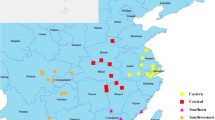Abstract
No prior studies in China have investigated the health impact of cold spell. In Shanghai, we defined the cold spell as a period of at least seven consecutive days with daily temperature below the third percentile during the study period (2001–2009). Between January 2001 and December 2009, we identified a cold spell between January 27 and February 3, 2008 in Shanghai. We investigated the impact of cold spell on mortality of the residents living in the nine urban districts of Shanghai. We calculated the excess deaths and rate ratios (RRs) during the cold spell and compared these data with a winter reference period (January 6–9, and February 28 to March 2). The number of excess deaths during the cold spell period was 153 in our study population. The cold spell caused a short-term increase in total mortality of 13 % (95 % CI: 7–19 %). The impact was statistically significant for cardiovascular mortality (RR = 1.21, 95 % CI: 1.12–1.31), but not for respiratory mortality (RR = 1.14, 95 % CI: 0.98–1.32). For total mortality, gender did not make a statistically significant difference for the cold spell impact. Cold spell had a significant impact on mortality in elderly people (over 65 years), but not in other age groups. Conclusively, our analysis showed that the 2008 cold spell had a substantial effect on mortality in Shanghai. Public health programs should be tailored to prevent cold-spell-related health problems in the city.


Similar content being viewed by others
References
Analitis A, Katsouyanni K, Biggeri A, Baccini M, Forsberg B, Bisanti L et al (2008) Effects of cold weather on mortality: results from 15 European cities within the PHEWE project. Am J Epidemiol 168:1397–1408
Anderson BG, Bell ML (2009) Weather-related mortality: how heat, cold, and heat waves affect mortality in the United States. Epidemiology 20:205–213
Baker-Blocker A (1982) Winter weather and cardiovascular mortality in Minneapolis-St Paul. Am J Public Health 72:261–265
Basu R, Samet JM (2002) Relation between elevated ambient temperature and mortality: a review of the epidemiologic evidence. Epidemiol Rev 24:190–202
Braga AL, Zanobetti A, Schwartz J (2002) The effect of weather on respiratory and cardiovascular deaths in 12 U.S. cities. Environ Health Perspect 110:859–863
Fong IW (2000) Emerging relations between infectious diseases and coronary artery disease and atherosclerosis. Can Med Assoc J 163:49–56
Foster KG, Ellis FP, Dore C, Exton-Smith AN, Weiner JS (1976) Sweat responses in the aged. Age Ageing 5:91–101
Haines A, Kovats RS, Campbell-Lendrum D, Corvalan C (2006) Harben Lecture—Climate change and human health: impacts, vulnerability, and mitigation. Lancet 367:2101–2109
Hajat S, Haines A (2002) Associations of cold temperatures with GP consultations for respiratory and cardiovascular disease amongst the elderly in London. Int J Epidemiol 31:825–830
Hassi J (2005) Cold extremes and impacts on health. In: Kirch W, Menne B, Bertollini R, (eds) Extreme Weather Events and Public Health Responses. Springer, Berlin, pp 59–67
Healy JD (2003) Excess winter mortality in Europe: a cross country analysis identifying key risk factors. J Epidemiol Community Health 57:784–789
Huang W, Kan H, Kovats S (2010) The impact of the 2003 heat wave on mortality in Shanghai, China. Sci Total Environ 408:2418–2420
Huynen MM, Martens P, Schram D, Weijenberg MP, Kunst AE (2001) The impact of heat waves and cold spells on mortality rates in the Dutch population. Environ Heal Perspect 109:463–470
IPCC (2007) Climate change 2007: the physical science basis. Contribution of Working Group I to the Fourth Assessment Report of the Intergovernmental Panel on Climate Change. Cambridge University Press, Cambridge, UK
Kan H (2009) Environment and health in China: challenges and opportunities. Environ Heal Perspect 117:A530–A531
Kan H, London SJ, Chen H, Song G, Chen G, Jiang L et al (2007) Diurnal temperature range and daily mortality in Shanghai, China. Environ Res 103:424–431
Knowlton K, Rotkin-Ellman M, King G, Margolis HG, Smith D, Solomon G et al (2009) The 2006 California heat wave: impacts on hospitalizations and emergency department visits. Environ Heal Perspect 117:61–67
Kysely J, Pokorna L, Kyncl J, Kriz B (2009) Excess cardiovascular mortality associated with cold spells in the Czech Republic. BMC Publ Health 9:19
Ma W, Xu X, Peng L, Kan H (2011) Impact of extreme temperature on hospital admission in Shanghai, China. Sci Total Environ 409:3634–3637
McMichael AJ, Wilkinson P, Kovats RS, Pattenden S, Hajat S, Armstrong B et al (2008) International study of temperature, heat and urban mortality: the 'ISOTHURM' project. Int J Epidemiol 37:1121–1131
Mercer JB (2003) Cold—an underrated risk factor for health. Environ Res 92:8–13
Nayha S (2002) Cold and the risk of cardiovascular diseases. A review. Int J Circumpolar Health 61:373–380
O'Neill MS, Zanobetti A, Schwartz J (2003) Modifiers of the temperature and mortality association in seven US cities. Am J Epidemiol 157:1074–1082
Revich B, Shaposhnikov D (2008) Excess mortality during heat waves and cold spells in Moscow, Russia. Occup Environ Med 65:691–696
Rothman KJ, Greenland S, Lash TL (2008) Modern epidemiology. Lippincott Williams & Wilkins, Philadelphia, PA
Tan JG, Kalkstein LS, Huang JX, Lin SB, Yin HB, Shao DM (2004) An operational heat/health warning system in Shanghai. Int J Biometeorol 48:157–162
Zeka A, Zanobetti A, Schwartz J (2006) Individual-level modifiers of the effects of particulate matter on daily mortality. Am J Epidemiol 163:849–859
Acknowledgements
The study was supported by the National Basic Research Program (973 program) of China (2011CB503802), the National Natural Science Foundation of China (30800892, 81001228 and 40905069), the Gong-Yi Program of China Ministry of Environmental Protection (201209008), and the Program for New Century Excellent Talents in University (NCET-09-0314).
Author information
Authors and Affiliations
Corresponding author
Rights and permissions
About this article
Cite this article
Ma, W., Yang, C., Chu, C. et al. The impact of the 2008 cold spell on mortality in Shanghai, China. Int J Biometeorol 57, 179–184 (2013). https://doi.org/10.1007/s00484-012-0545-7
Received:
Revised:
Accepted:
Published:
Issue Date:
DOI: https://doi.org/10.1007/s00484-012-0545-7




